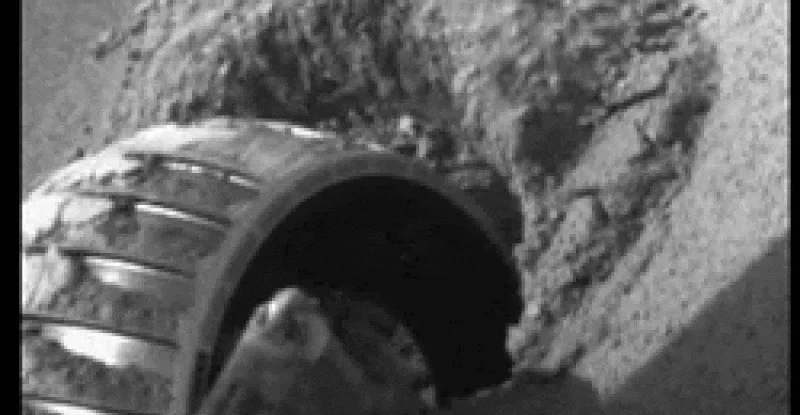NASA Rovers Getting Stuck: 3 Surprising Reasons UW Engineers Found
NASA rovers getting stuck has been a frustrating and costly challenge for space exploration. From Spirit’s final days trapped in Martian sand to Curiosity’s tense moments in loose soil, these high-tech machines have faced terrain problems that even Earth-based testing failed to predict. Now, groundbreaking research from UW–Madison engineers has uncovered the surprising reason behind this recurring issue — and it could change how we prepare rovers for future Moon and Mars missions.
Why NASA Rovers Getting Stuck Has Puzzled Scientists for Years
Rovers have gotten stuck repeatedly. For example, the Mars Spirit rover became permanently embedded in Martian sand in 2009 despite Earth’s solvers twisting commends from hundreds of millions of miles away to free it. Even Curiosity experienced bogging in soft terrain later on.
Engineers have long dealt with these crises remotely, issuing wheel-turn and back-up commands in painstaking attempts to extricate the vehicles—often with limited success.
Simulating Planetary Conditions—The Old Way
To prepare rovers for extraterrestrial missions, engineers conduct Earth-based trials. One key method: build a lightweight prototype about 1/6 the mass of the actual rover to mimic reduced gravity—like on the Moon or Mars—and drive it across Earth’s sandy deserts.
The logic: lower the weight, and you simulate the way gravity affects the rover.
This has been standard practice for decades—until the recent simulations from UW–Madison revealed a hidden oversight.
The Hidden Cause Behind NASA Rovers Getting Stuck
Dan Negrut and his team at the University of Wisconsin–Madison discovered that Earth’s strong gravity doesn’t just affect the rover—it also compacts the sand. What seems like a trivial detail turns out to be monumental: Earth’s pull makes sand more rigid and supportive, while Mars or the Moon have “fluffier,” less cohesive soils.
Simply scaling down a rover’s mass doesn’t account for how Earth gravity compresses the sand. The result? Earth tests consistently overestimate rover traction—giving engineers a false sense of security.
Simulations That Finally Solved the NASA Rovers Getting Stuck Problem
Using Project Chrono, an open-source physics simulation engine, Negrut’s team modeled real rovers operating on virtual lunar and Martian terrain—capturing the exact behavior of both vehicle and granular soil under low-gravity conditions.
While modeling the VIPER lunar rover (funded by NASA), they noticed huge discrepancies between their Chrono simulations and Earth-based physical testing. The simulations revealed that sand under low gravity shifts and collapses far more readily—and unreliably—than Earth-based tests suggested.
The key insight: rover performance is more threatened by unstable substrate than we thought. Tests ignoring soil behavior under low gravity mislead mission planners—rover missions could face serious mobility risks.
What This Means for Future Rover Missions
-
More Accurate Testing
By considering sand behavior under reduced gravity, engineers can design and test better prototypes—more likely to reflect real mission conditions. -
Safer Rover Missions
Knowing the terrain’s tendency to shift means mission teams can better anticipate—and avoid—getting stuck in Martian dunes or lunar regolith. -
Beyond Space Exploration
Project Chrono is being used across industries—from off-road military vehicles to precision watchmaking—highlighting the far-reaching utility of physics-based simulation. - Open Science, Broad Impact
Chrono is freely available to the public, maintained by UW–Madison and collaborators. That makes it a powerful tool for research across disciplines.
Rewriting the Rover Playbook
What comes next? Here’s how this insight could transform future missions:
-
Revised Testing Protocols
Earth-based prototypes should be tested in simulated low-gravity terrains—or using simulation platforms like Chrono—to mimic the real behavior of alien soils. -
Terrain-Aware Rover Design
Future rovers may adopt improved suspension, wheel design, or traction control to handle shifting regolith effectively. -
Predictive Mission Planning
Chrono simulations could inform route planning—identifying areas where rovers should avoid or proceed cautiously. -
Continued Research
The study, published in the Journal of Field Robotics, offers a foundation for more refined research into gravity-soil-rover interactions across planetary surfaces.
Conclusion: Preventing NASA Rovers Getting Stuck in the Future
In conclusion, the reason NASA’s rovers keep getting stuck isn’t purely due to flawed hardware or unexpected Martian dunes—it’s the ground itself behaving differently under low-gravity. By focusing not just on the rover but on how gravity affects the soil, UW–Madison engineers have illuminated a critical oversight in traditional testing.
Their use of Project Chrono brings a new era of realism to rover testing—paving the way for smarter, safer planetary exploration. Now, when NASA sends its next rover to push boundaries on Mars or the Moon, it might just be better prepared to navigate the unpredictable landscapes of other worlds.
The research has been published in the Journal of Field Robotics.
For those interested in other cosmic or extreme-risk topics, check out our posts like
Hubble Captures Interstellar Comet 3I/ATLAS in Stunning Detail
Asteroid Impact Probability: Shocking 1 in 155 Odds of a Strike in Your Lifetime,

